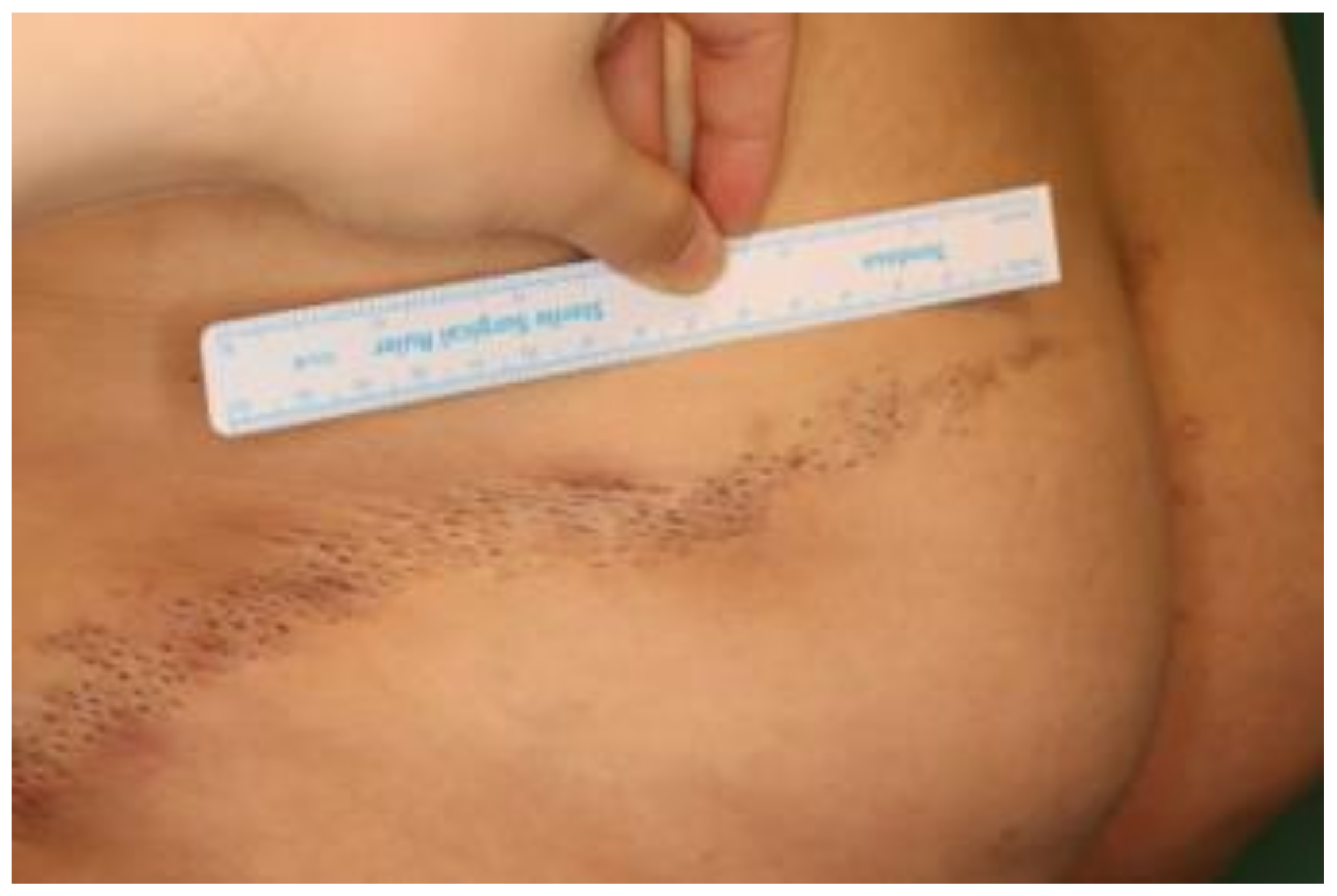Nevus Comedonicus Syndrome Associated with Psychiatric Disorder
Abstract
1. Introduction
2. Case Report
3. Discussion
4. Conclusions
Author Contributions
Funding
Institutional Review Board Statement
Informed Consent Statement
Data Availability Statement
Conflicts of Interest
References
- Kofmann, S. A case of rare localization and distribution of comedones. Arch. Dermatol. Syph. 1895, 32, 177–178. [Google Scholar] [CrossRef]
- Arias-Santiago, S.; Aneiros-Fernandez, J.; Buendía-Eisman, A.; Girón-Prieto, M.S.; Aneiros-Cachaza, J. A 5-year-old boy with comedo-like lesions on the right buttock. Dermatol. Online J. 2010, 16, 11. [Google Scholar] [CrossRef] [PubMed]
- Mahajan, R.S.; Shah, M.M.; Ninama, K.R.; Bilimoria, F.E. Extensive nevus comedonicus. Indian Dermatol. Online J. 2014, 5, 520–521. [Google Scholar] [CrossRef] [PubMed]
- Levinsohn, J.L.; Sugarman, J.L.; Yale Center for Mendelian, G.; McNiff, J.M.; Antaya, R.J.; Choate, K.A. Somatic Mutations in NEK9 Cause Nevus Comedonicus. Am. J. Hum. Genet. 2016, 98, 1030–1037. [Google Scholar] [CrossRef] [PubMed]
- Torchia, D. Nevus comedonicus syndrome: A systematic review of the literature. Pediatr. Dermatol. 2021, 38, 359–363. [Google Scholar] [CrossRef] [PubMed]
- Vidaurri-de la Cruz, H.; Tamayo-Sánchez, L.; Durán-McKinster, C.; de la Luz Orozco-Covarrubias, M.; Ruiz-Maldonado, R. Epidermal nevus syndromes: Clinical findings in 35 patients. Pediatr. Dermatol. 2004, 21, 432–439. [Google Scholar] [CrossRef] [PubMed]
- Happle, R. Epidermal nevus syndromes. Semin. Dermatol. 1995, 14, 111–121. [Google Scholar] [CrossRef]
- Casey, J.P.; Brennan, K.; Scheidel, N.; McGettigan, P.; Lavin, P.T.; Carter, S.; Ennis, S.; Dorkins, H.; Ghali, N.; Blacque, O.E.; et al. Recessive NEK9 mutation causes a lethal skeletal dysplasia with evidence of cell cycle and ciliary defects. Hum. Mol. Genet. 2016, 25, 1824–1835. [Google Scholar] [CrossRef] [PubMed]
- Shaheen, R.; Patel, N.; Shamseldin, H.; Alzahrani, F.; Al-Yamany, R.; Almoisheer, A.; Ewida, N.; Anazi, S.; Alnemer, M.; Elsheikh, M.; et al. Accelerating matchmaking of novel dysmorphology syndromes through clinical and genomic characterization of a large cohort. Genet. Med. 2016, 18, 686–695. [Google Scholar] [CrossRef] [PubMed]
- Faraone, S.V.; Larsson, H. Genetics of attention deficit hyperactivity disorder. Mol. Psychiatry 2019, 24, 562–575. [Google Scholar] [CrossRef] [PubMed]



Publisher’s Note: MDPI stays neutral with regard to jurisdictional claims in published maps and institutional affiliations. |
© 2022 by the authors. Licensee MDPI, Basel, Switzerland. This article is an open access article distributed under the terms and conditions of the Creative Commons Attribution (CC BY) license (https://creativecommons.org/licenses/by/4.0/).
Share and Cite
Woo, H.Y.; Kim, S.K. Nevus Comedonicus Syndrome Associated with Psychiatric Disorder. Diagnostics 2022, 12, 383. https://doi.org/10.3390/diagnostics12020383
Woo HY, Kim SK. Nevus Comedonicus Syndrome Associated with Psychiatric Disorder. Diagnostics. 2022; 12(2):383. https://doi.org/10.3390/diagnostics12020383
Chicago/Turabian StyleWoo, Ha Young, and Sang Kyum Kim. 2022. "Nevus Comedonicus Syndrome Associated with Psychiatric Disorder" Diagnostics 12, no. 2: 383. https://doi.org/10.3390/diagnostics12020383
APA StyleWoo, H. Y., & Kim, S. K. (2022). Nevus Comedonicus Syndrome Associated with Psychiatric Disorder. Diagnostics, 12(2), 383. https://doi.org/10.3390/diagnostics12020383




